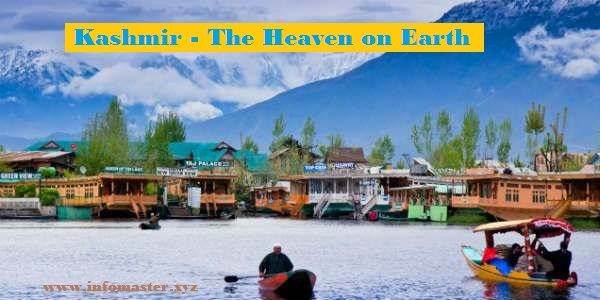Kashmir – The Heaven on Earth
 Mughal Emperor Jahangir once quoted “Gar Firdaus, Ruhe zamin ast, hamin asto, hamin asto, hamin ast” to portray Kashmir, the Switzerland of India. That means if there is anywhere heaven on earth, it is here.
Mughal Emperor Jahangir once quoted “Gar Firdaus, Ruhe zamin ast, hamin asto, hamin asto, hamin ast” to portray Kashmir, the Switzerland of India. That means if there is anywhere heaven on earth, it is here.
Kashmir is considered to be the heaven on earth due to its beauty that includes rivers, mountains, temples, major markets, garden, wildlife or forests and everything that a tourist want. Indeed, Valley of Kashmir is situated between the Himalayas of India and the Pir Panjal mountain range. Jammu and Kashmir is the northernmost state of India. Jammu is famous for its natural beauty, ancient temples, Hindu religious sites, palaces, gardens, and kilos. Given Paradise on Earth, the mountainous landscape of Kashmir has been attracting tourists for centuries. This is one of the chief tourist destinations of India. The most important places to explore in Jammu and Kashmir are Srinagar, Mughal Gardens, Pahalgam, Gulmarg, Yusargarg and Mughal Gardens, Leh and Ladakh, Dal Lake, etc. However, due to an insurgency, the tourism industry is badly affected.
History
Kashmir has many legends. There is an ancient myth that it was a lake before, where Kashmir stands now. An evil presence used to live inside the lake and made trouble for humanity. He was later on killed by Goddess Parvati with Maharshi Kashyap. It is said that the Goddess and Kashyap drained the water out from the lake to find out the evil spirit, and the land mass which was then left is today’s Kashmir.
Kashmir has memories of both Hindu and Muslim rulers. Later on, the Sikhs also have ruled the land until the emergence of the British in India. The significant accounts of Buddhism and Maurya Emperor Ashoka have improved Kashmir’s history.
Today, Kashmir is bordered by the Republic of China in its northeast (Aksai Chin and the Trans-Karakoram Tract), Pakistan in the west that they have named Azad Kashmir and Gilgit–Baltistan; the rest are protected by the Indian Army. But whatever may be the reason behind the political unrests and tensions in the borders, it couldn’t demoralize the spirit of the tourists to explore Kashmir all throughout the year.
Top Attractions
Your trip to Kashmir will remain incomplete without enlisting the sightseeing during the tour. Here we have picked some of the top listed attractions in Kashmir that you can’t afford to miss.
Kashmir is the land of flowers in the spring and snow in the winter. You may have a feeling that living in the houseboats and voyaging in the shikhara can be the ultimate to explore in Kashmir. But only after exploring the magnificent sightseeing you can comprehend why Kashmir is the Switzerland of India?
Sonamarg
Sonamang means the Meadow of Gold- is located on the Srinagar Ladakh Highway at a distance of 2 hours drive from Srinagar. This place is well-known to tourists for the Thajiwas Glacier. Besides, travelers can get a chance to hike up the glacier to enjoy the thrill of trekking and explore the spectacular beauty of Sonamarg in total 5 hours. If you are not willing to trek or have elderly family members with you, then you can hire the pony services that will charge you INR 600 per person approx. Here you are free to bargain hard for the best deal. This has been one of the most popular Bollywood shooting spots for decades. Staying at Sonamarg can be the best option for honeymooners. There are plush hotels and resorts among which Ahsan Mount Resort and Hotel Snowland deserve special mention. Here you can enjoy the Swiss tents to glamp.
Pahalgam
Locally, this is known as the Land of Shepherds, a three-hour drive from the city of Srinagar. The Amarnath Yatra pilgrims depart from here. July and August remain crowded as this is the time of the Yatra to Amarnath Ji.
Tourists enjoy the lovely view of the Betaab Valley that was named after a famous Bollywood movie “Betaab”, beside the murmuring river Lidder and the snow-capped mountains bordering the valley. You can take the vehicle up to a certain point in the Betaab Valley. From there you will either have to hire a local mode of transportation say a car or else have to trek. They will charge you INR 10 to enter the valley.
Gulmarg
The meaning of Gulmarg is “Meadow of Flowers”, is the ideal ski resort of Kashmir. In just a two hour drive from east Srinagar, you can reach Gulmarg. If you are not a “ski” person, you can trek to 13,000 feet up to Mount Apharwat to witness the spectacular panoramic views from the top.
The Khyber Himalayan Resort and Spa located in Gulmarg is one of the Top 10 Himalayan Spa Resorts.
Some other top attractions of Kashmir are-
Charar-i-Sharief and Yousmarg, Dal Lake, Nagin Lake, Gulmarg Gondola, Zozila Pass, Kheer Bhawani Mandir, Shankaracharya Hills, Indira Gandhi Tulip Garden, Mughal Gardens, Thajiwas Glacier, Sinthan Top and many more.
Dal Lake – The Hazrat Bahm Masjid located on the banks of the famous Dal Lake, must be seen here. Charar-e-Sharif is one of the oldest and most revered religious places in Kashmir. This religious place, situated at a distance of Srinagar, was constructed in memory of a famous Kashmiri Sufi saint Nuruddin.
Jhelum River– Khankah Shah Shahjahan located on the banks of this is another tourist destination. The main features of this include nude bells and carved leaves. This religious site was constructed by Alexander in 1835.
Temple of Kheer Bhawani – 27 kilometers from Srinagar is a temple of Kheer Bhavani. This temple was built by Maharaja Pratap Singh. This temple has a statue of Hindu Goddess Ragnya. It is believed that Shri Ram Chandra used this temple as a place of worship at the time of his exile. Only one Indian sweet kheer and milk are offered by devotees in this temple.
Shankaracharya Temple– Shankaracharya Temple is situated on a high hill. This is another tourist destination of Kashmir. This temple attracts many tourists. It is located near the city of Anantnag in Kashmir. This temple was built by Raja Lalitaditya of the Sun Dynasty.
Shiv Khori – The natural cave of Shiv Khori is known for its natural form of Shivling which is the symbolic form of the Hindu god Shiva of Destruction. It is located 100 kilometers from Jammu. Pictures of Hindu snake deity Sheshnag can be seen on the roof of the cave. A cavity can be seen in the center of the cave, which is a symbol of Shiva ji or tangled hair.
Soothing Garden – Shalimar Garden, which was built by Emperor Jahangir for his wife Noor, is also very popular. The Garden of Love located here is also very famous. There is a pond in it, the center of the black stone at the center. Light and music show organized in this garden attract many tourists.
Best time to visit:
October to March
How to reach Kashmir?
- Train Connectivity: The Jammu-Tawai is the nearest Railway Junction that connects almost all major cities across India.
- Air Connectivity: Srinagar is the nearest Airport to Kashmir. This is around 14 km from Kashmir. The airport is connected to all major cities in India such as New Delhi, Pune, Mumbai and more.
- Bus connectivity: From the bus, there are two ways to reach the bus. While being a Jammu, in Srinagar or Himachal Pradesh, Leh can reach Manali.
Languages are spoken in Jammu and Kashmir–
The official language of this state is Urdu. This language is written in Persian Leipi. These languages are mostly spoken in the whole of Jammu and Kashmir. Other languages are also spoken here such as Ladakhi, Kashmiri, Dogri, Batti, Pahadi, Gojari, Pashto and Shina.
Lifestyle & dressings of the people of Jammu and Kashmir
Catering – People living in this state drink peanuts and pink tea. Handicrafts, tourism are the main industries in the state of Jammu and Kashmir. Kashmiri people eat consignments like Yakhini, Rogan Josh, Goshiba, Modaur Pulao, Rajma Gogi, Mujad Gad, Sune Pulao, Kanti, Dum Oluv, Nadir Vangan etc.
Jewelry: Jewelry in Jammu and Kashmir culture is the custom of wearing and they also use sapphire, turquoise, milky stone, bellori, panna and sulmani stone to make these gahenes more attractive. Kashmiri people call the jeweler worn in the ears as Kan-Waji, Atta-Hur, Kanye Far, Jhumka and Deja-Hore. Vaccine and jigni ornaments are worn on the skull.
Dress– The traditional Porsak of the state of Kashmir is a full shirt and wide pajamas. A bundi (tunic) is worn on this paurak, which is like a coat without arms, also called a Sadri. The round cap of the work on the head is worn. Women used to be swinging very much from the clothes of the men. A Poshak of Muslim Kashmiri woman was called Kasaba. And the Kashmiri Pandit women’s clothes were called ropes. At present, the people of Jammu and Kashmir have a trend of modern western textiles.


